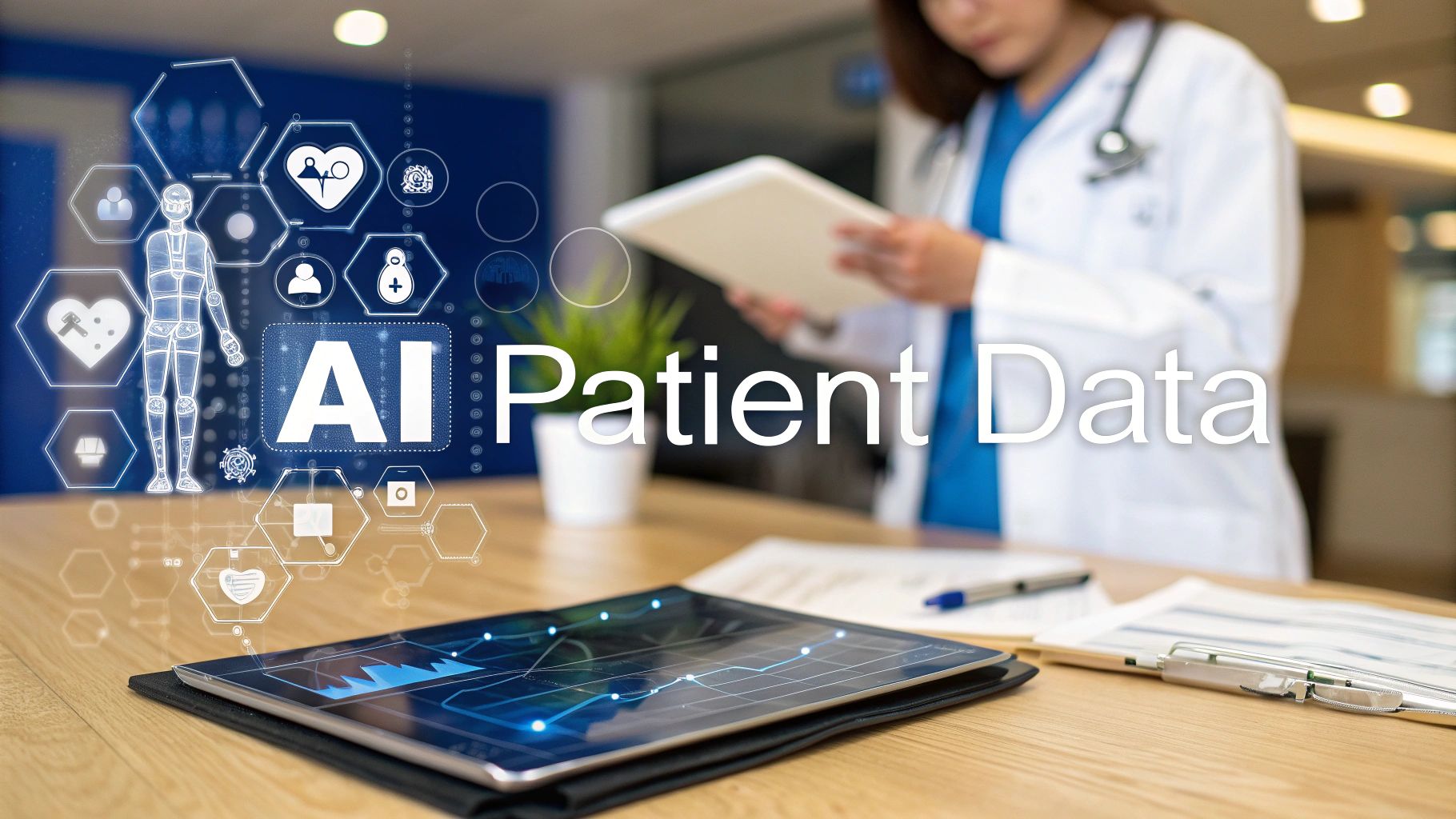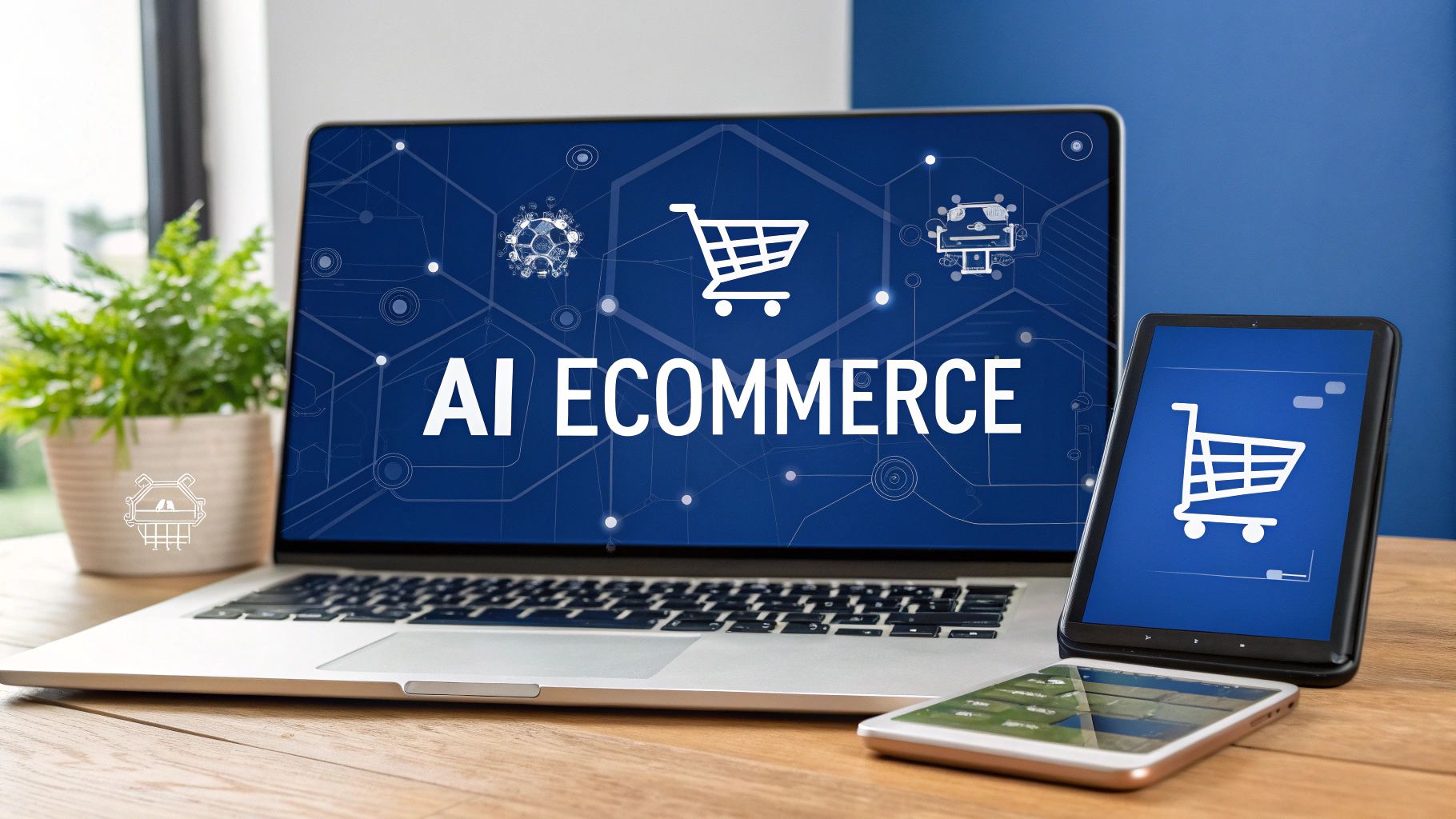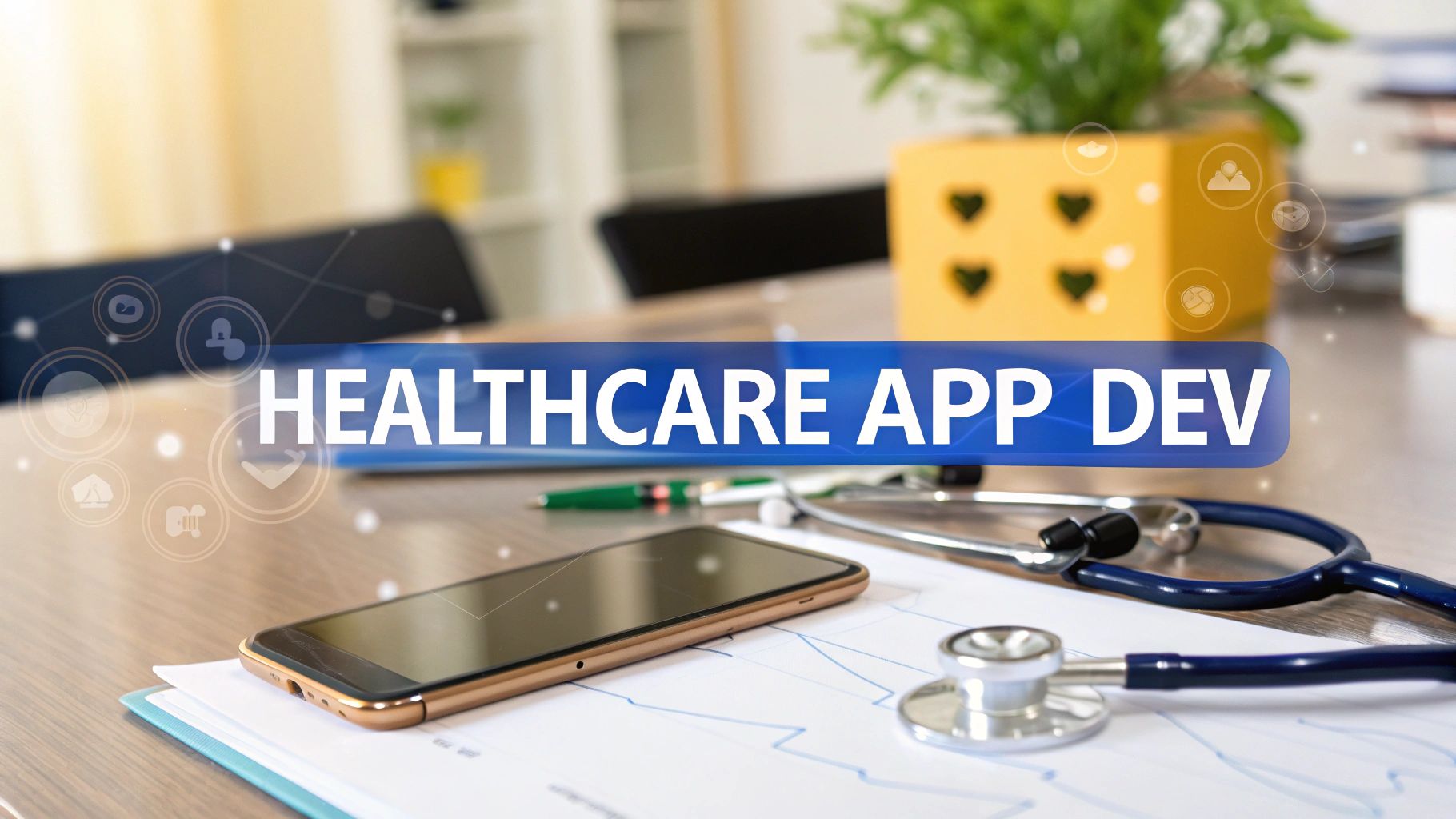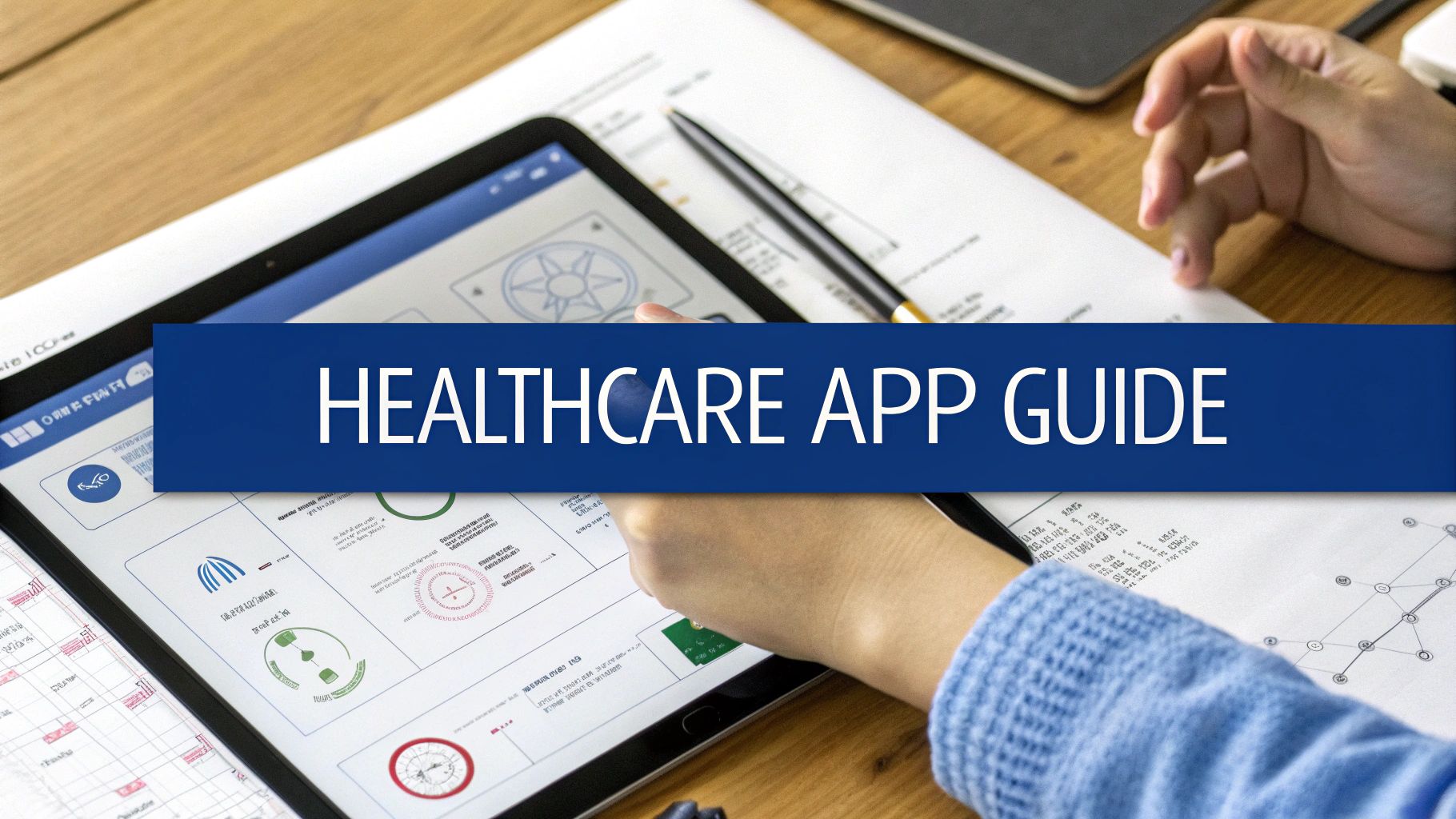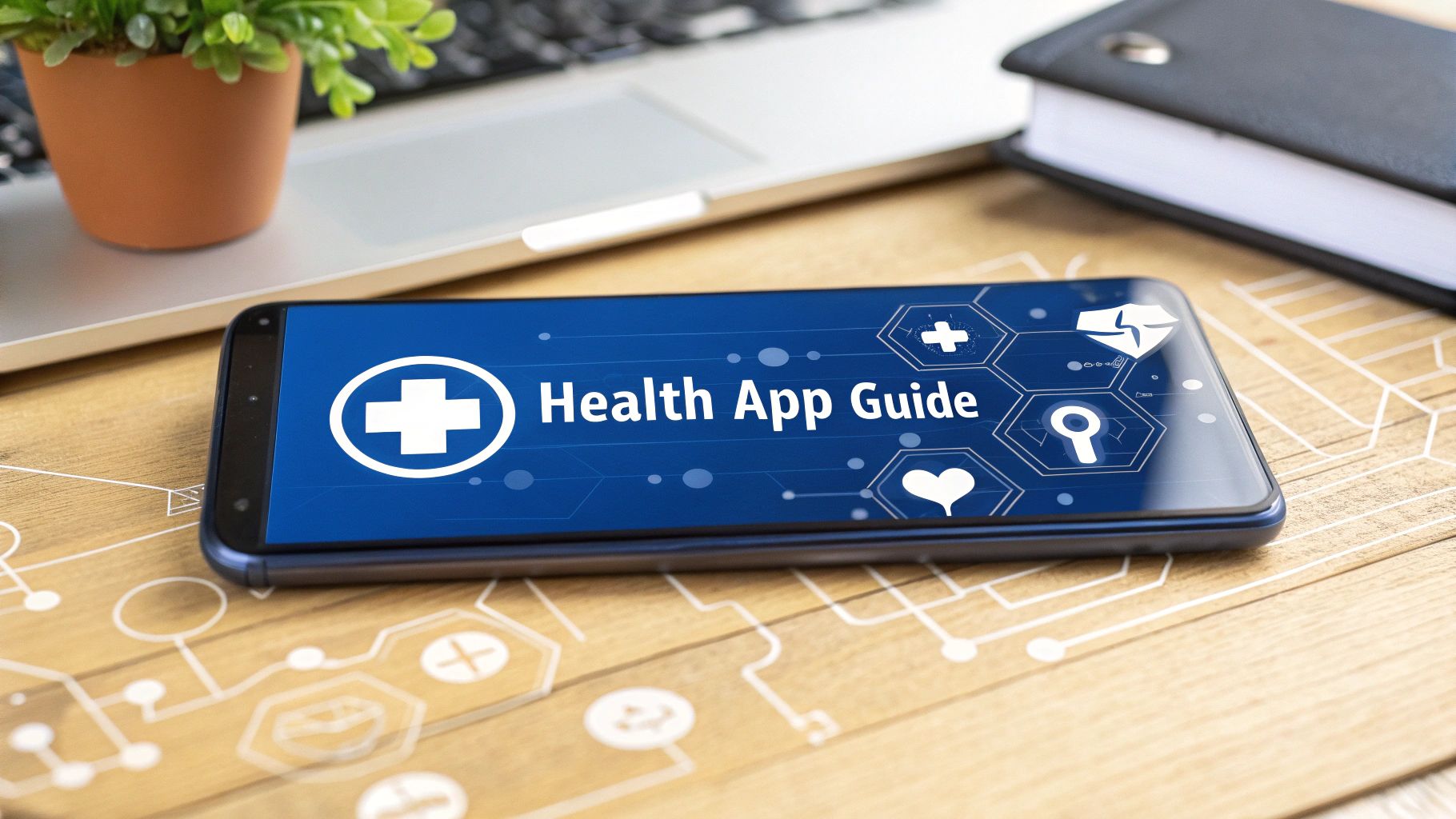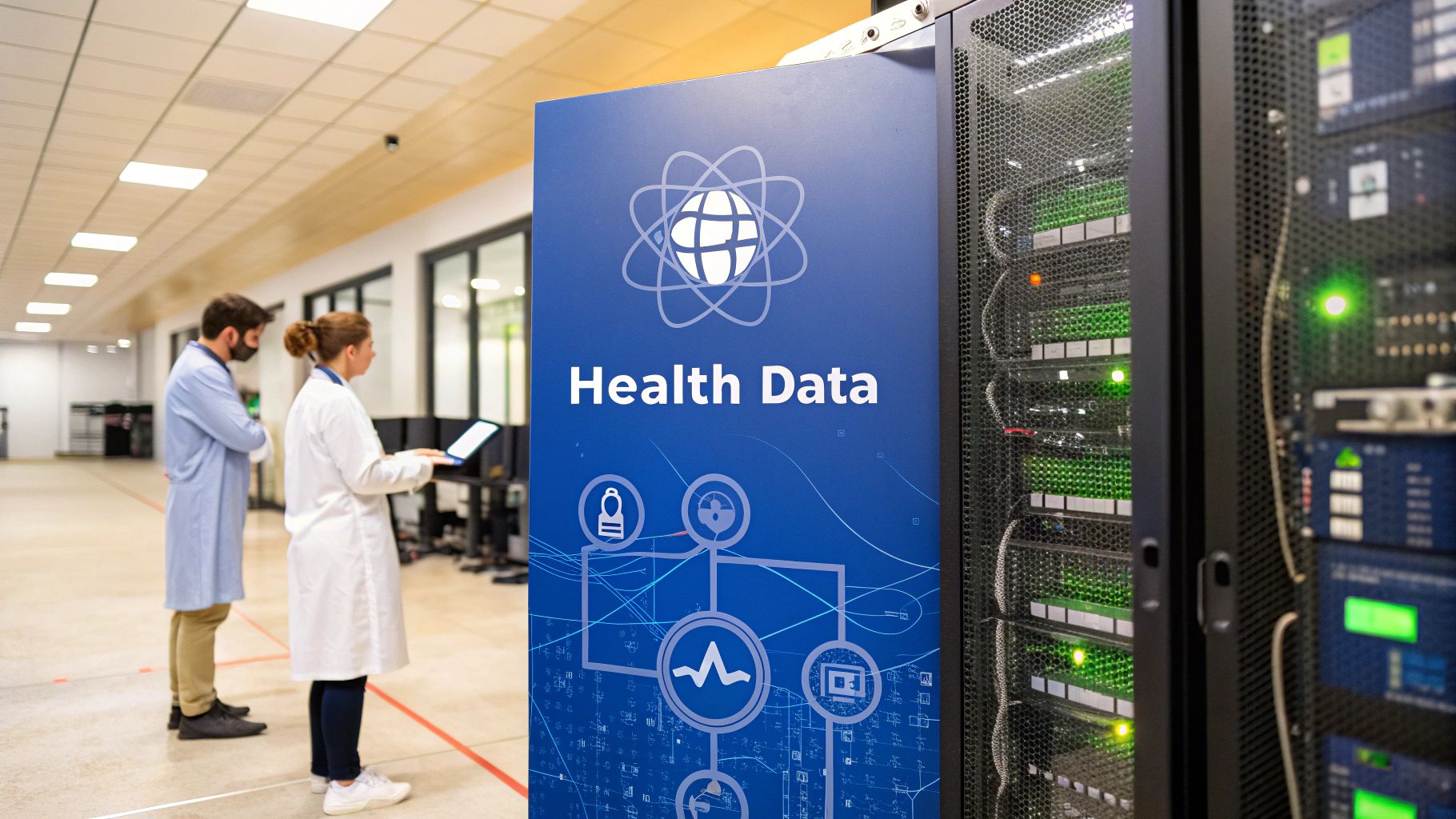Picture this: a clinic where patient files aren't just static digital folders but living, breathing sources of insight, updated instantly without a single manual keystroke. This is what AI-powered patient data management offers. It’s a shift from the old way of doing things, like fragmented, reactive record-keeping, to a model that's proactive, predictive, and truly personal.
It's all about making data finally work for the patient, instead of just sitting in a digital file cabinet.
Why AI is a Game-Changer for Patient Data Management
Healthcare has never been short on data. The real challenge has always been wrestling it into a usable format. Patient information is typically scattered across a dozen different systems: electronic health records (EHRs), lab reports, billing software, and imaging archives. This creates frustrating information silos.
This disorganization isn't just inefficient; it leads to a significant amount of administrative work and, more importantly, can result in missed opportunities for delivering better care. In fact, a staggering 80% of all healthcare data is unstructured. We're talking about handwritten notes, dictated audio files, and scanned documents that traditional software can't make heads or tails of.
AI brings a completely new approach to this problem. Instead of just storing information, AI-powered systems can actually understand, organize, and interpret it. Think of it as an incredibly smart clinical assistant who can sift through mountains of data to find hidden patterns, automate the most tedious tasks, and free up medical staff to focus on their patients.

From Reactive Records to Proactive Care
Traditional data management is stuck in the past; it records what has already happened. An AI-driven system looks to the future; it analyzes current and historical data to predict what could happen next. This is a fundamental change in how healthcare is delivered.
This is where true transformation happens. The core benefits really stand out:
-
A Complete Patient Picture: AI can pull together information from all those scattered sources to create a single, comprehensive "360-degree patient view." This gives clinicians the full story of a patient's health at a glance.
-
Less Admin, More Care: It automates mind-numbing tasks like data entry, transcription, and medical coding, which are major contributors to clinician burnout. One recent report found that 57% of physicians believe automating these tasks is AI's biggest potential win.
-
Smarter Clinical Decisions: AI algorithms can flag potential drug interactions, spot patients at high risk for chronic diseases, and even suggest personalized treatment plans based on an individual's unique data profile.
This isn't just a tech upgrade. It's a strategic shift toward a smarter, more efficient healthcare system. By making data easy to access and act on, AI gives providers the tools they need to deliver better, more personalized care to everyone.
To really get a handle on the bigger picture of how AI helps organize clinical knowledge, the principles of knowledge management in healthcare are worth exploring. The end goal isn't just to hoard more data; it's to build an intelligent system that learns and gets better with every single patient interaction.
How AI Systems Understand Patient Data
So, how does an AI actually "understand" patient data? It's not like a doctor reading a chart. Instead, think of it as a super-powered organizer faced with a puzzle scattered across a thousand rooms. AI uses a set of specialized tools to rapidly sort, connect, and spot patterns in that data, patterns that would be impossible for any one person to see.
This isn't just one single technology at work. It’s a coordinated effort between several powerful systems, each playing a specific role. One might translate a doctor's handwritten notes into usable data, while another scans an X-ray for subtle anomalies. Together, they turn a chaotic flood of raw information into organized, meaningful intelligence.
The Three Pillars of AI in Healthcare Data
At the core of AI-powered patient data management are three key technologies. These are the foundational building blocks that allow a system to make sense of everything from clinical notes to complex medical imagery, transforming unstructured information into genuinely useful insights.
This infographic breaks down how these technologies work together to handle the different types of data found in healthcare.
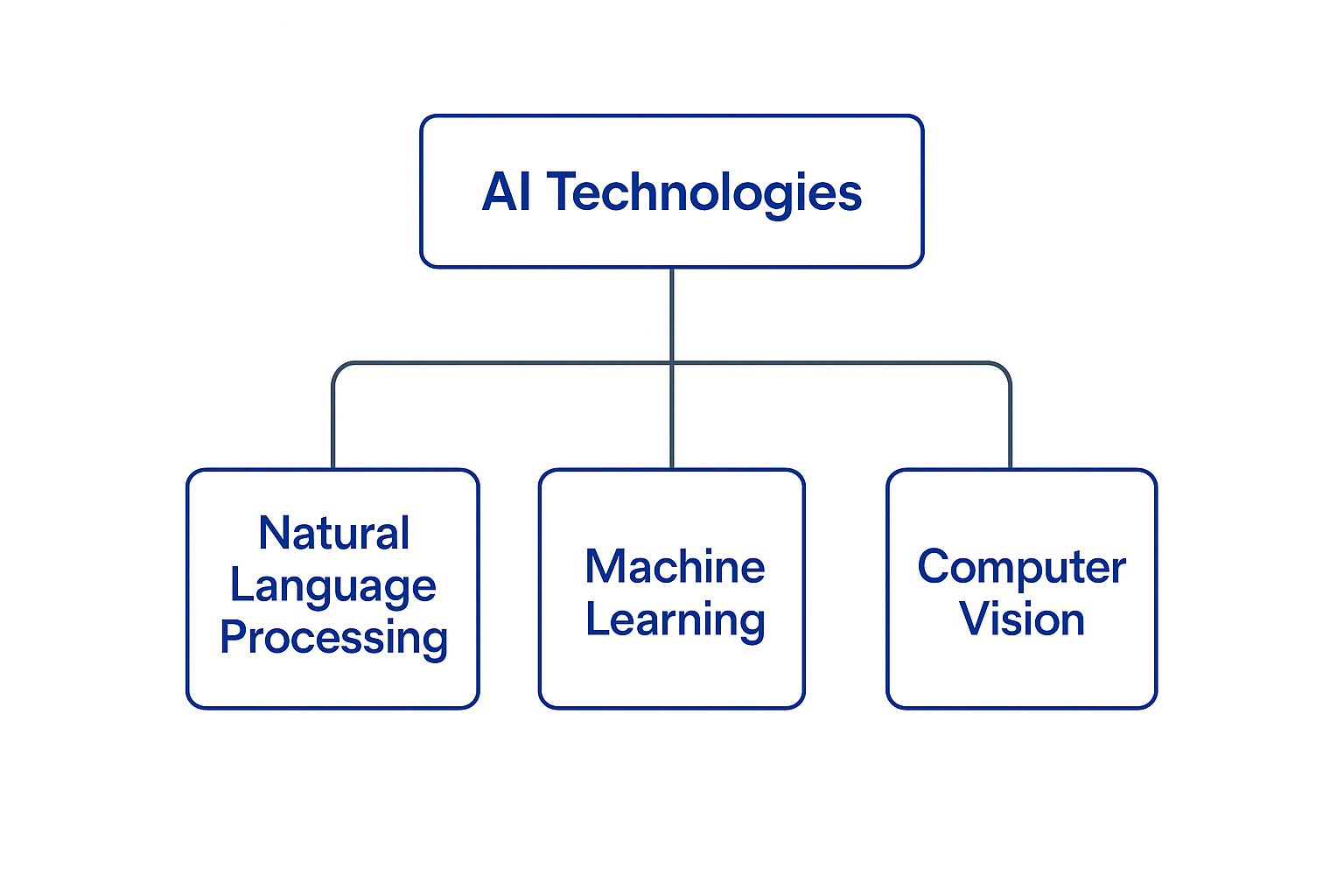
As you can see, each pillar tackles a unique data challenge, whether it’s understanding text, finding patterns, or interpreting images.
-
Natural Language Processing (NLP): This is the AI's "translator." A staggering amount of patient information, up to 80%, is locked away in unstructured text like doctors' notes, lab reports, and patient emails. NLP algorithms read and interpret this human language, pulling out crucial details like symptoms, diagnoses, and medications, and organizing them for analysis.
-
Machine Learning (ML): Think of this as the "prediction engine." Once the data is structured, ML models get to work. They are trained to find patterns and make forecasts. For instance, an ML algorithm can analyze thousands of patient files to flag individuals who are at high risk for a certain disease, paving the way for proactive care.
-
Computer Vision: This is the AI's set of "eyes." Computer vision algorithms are designed to analyze medical images like X-rays, MRIs, and CT scans with incredible precision. They can spot tiny abnormalities, measure tumours, or highlight anomalies a human radiologist might miss, acting as a valuable second opinion.
A New Approach to Data Management
Bringing these technologies into the fold represents a massive shift from older data management methods. Traditional systems were basically just digital filing cabinets, great for storing information, but not so good for finding insights within it. An AI-powered system, on the other hand, is dynamic. It’s constantly learning from new data to support clinical decisions as they happen.
By combining NLP, ML, and computer vision, AI doesn't just store patient data; it actively engages with it. This proactive analysis is what unlocks the potential for more personalized treatments, earlier diagnoses, and a more efficient healthcare system overall.
The real-world impact of these technologies is already reshaping tools like electronic health records (EHRs). As detailed in our guide on AI-driven EHR solutions, adding AI can automate tedious data entry and give clinicians smart summaries, freeing them up from a mountain of administrative work.
To really see the difference, let’s compare the old and new approaches side-by-side.
Traditional vs AI-Powered Patient Data Management
This table highlights just how different the two approaches are, moving from passive storage to active intelligence.
|
Feature |
Traditional Data Management |
AI-Powered Data Management |
|---|---|---|
|
Data Handling |
Manual data entry and static storage. |
Automated data ingestion and dynamic analysis. |
|
Data Type |
Primarily structured data (e.g., forms, numbers). |
Handles both structured and unstructured data (notes, images). |
|
Insight Generation |
Requires manual queries and reports by staff. |
Proactively identifies patterns and predicts outcomes. |
|
Decision Support |
Limited to historical data review. |
Offers real-time alerts and predictive recommendations. |
|
Scalability |
Becomes slow and cumbersome with large datasets. |
Scales efficiently to analyze massive volumes of data. |
Ultimately, this evolution in technology lets healthcare organizations do much more than just keep records. The goal is to create a system where data becomes an active partner in patient care, making the entire process smarter and more responsive to every individual's needs.
Reducing Clinician Burnout with AI Automation
One of the biggest wins for AI in patient data management is its potential to solve a crisis that’s been brewing for years: clinician burnout. The administrative burden on doctors, nurses, and other healthcare professionals has ballooned to an unsustainable level. Many find themselves spending more time wrestling with paperwork and data entry than actually caring for patients. This isn't just an inefficiency issue; it's a direct threat to the quality of care and the health of the very people we rely on to keep us well.
This is where AI automation steps in. It acts as a powerful assistant, taking on the repetitive, time-consuming tasks that sap clinicians' energy and focus. The entire point is to offload the clerical work so that skilled professionals can get back to doing what they were trained to do. It’s a fundamental shift toward building a healthier, more sustainable healthcare environment for everyone.

Freeing Clinicians from the Keyboard
Picture a doctor finishing up a consultation without once having to turn to a keyboard to update the patient's record. This isn’t a far-off dream; it's the reality offered by ambient AI scribes. These systems securely listen to the conversation between a patient and their doctor and then automatically draft the detailed clinical notes.
Just this one application can give clinicians hours back in their day. Instead of sticking around after hours to catch up on documentation, they can leave on time, feeling more present and less drained. That reclaimed time and energy translates directly into better patient interactions: a less-stressed doctor is a more attentive and empathetic one.
We're already seeing this technology make a real difference. In California, for example, AI is changing how clinics operate by automating these exact kinds of tasks. A recent analysis found that 57% of physicians believe automating administrative work is AI’s most significant opportunity. AI scribes are handling documentation, while some radiology practices are using AI to auto-generate parts of reports, cutting down their cognitive load by as much as 99%. You can dig deeper into AI's growing role in California's healthcare system to see the full scope.
Key Areas Where AI Reduces the Administrative Load
It’s not just about scribing, though. AI automation is chipping away at administrative work across a number of key functions, each one designed to give precious time back to providers.
-
Automated Medical Coding: AI algorithms can scan clinical notes and suggest the right billing codes. This cuts down on errors and saves a ton of time for both clinicians and billing staff.
-
Intelligent Scheduling: Instead of staff manually juggling appointments, AI-driven systems can manage calendars, optimising them for urgency and resource availability, while automatically handling cancellations and rescheduling.
-
Prior Authorisation Automation: Getting pre-approval for treatments is a notorious bottleneck. AI can help by automatically compiling and submitting the necessary paperwork, which means patients can get the care they need much faster.
These aren't just ideas on a whiteboard; they are practical solutions being built right now. Of course, creating tools this sophisticated takes a specific skill set, which is why specialized Healthtech Software Development Services are so important for turning these concepts into reliable clinical tools.
By automating the background noise of healthcare administration, AI empowers clinicians to reconnect with the core purpose of their profession, caring for patients. This not only reduces burnout but also fundamentally improves the patient experience.
Ultimately, bringing this kind of technology into healthcare is about creating a more humane and efficient system. The right AI Development Services focus on designing systems that fit neatly into existing workflows, ensuring the tech serves the people, not the other way around. This thoughtful approach is the key to building trust and encouraging widespread adoption.
Real-World Examples of AI in Patient Care
Let's move beyond theory and look at how AI is already saving lives in hospitals and clinics. These aren't futuristic concepts; they are practical tools making a real difference today. By digging through massive, complex patient datasets, AI is helping doctors spot diseases earlier, foresee health crises before they happen, and customize treatments for each individual.
Think of AI as a powerful partner for clinicians. It sifts through information at a speed and scale no human team could ever hope to match, uncovering subtle patterns that can signal serious health problems. The result is a more proactive, precise, and ultimately more human-centred approach to medicine.

Predicting Sepsis Before It Strikes
Sepsis is a brutal, life-threatening reaction to an infection that can escalate with terrifying speed. It's also notoriously tricky to diagnose in its early stages. To get ahead of it, many hospitals are turning to predictive analytics.
AI algorithms work tirelessly in the background, constantly scanning patient data from electronic health records (EHRs). They analyze everything, including vital signs, lab results, and doctors' notes, in real-time. By catching subtle combinations of risk factors that might slip past a busy care team, the system flags patients at high risk. This early warning gives doctors a critical window to intervene, which has a massive impact on survival rates. It's a perfect example of using data not just for records, but for active, life-saving predictions. To see more on this, check out our guide on predictive healthcare with AI.
Enhancing Diagnostic Accuracy in Medical Imaging
Radiology is another area where AI is already making its mark. AI-powered tools can analyze X-rays, MRIs, and CT scans with a level of precision that complements human expertise, often spotting faint signs of disease that are almost invisible to the naked eye.
For instance, an AI trained on thousands of mammograms can highlight tiny, suspicious calcifications that might be the earliest signs of breast cancer. This doesn't replace the radiologist. Far from it. It acts as a vigilant second set of eyes, drawing their attention to areas that need a closer look. This tag-team approach between human experience and AI accuracy leads to earlier diagnoses, less invasive treatments, and better outcomes for patients.
Personalizing Treatment Plans with AI
The days of one-size-fits-all medicine are numbered. AI is speeding up the shift toward highly personalized care plans. By analyzing a patient's unique genetic code, lifestyle factors, and medical history, AI models can predict how they'll respond to different drugs and therapies.
In oncology, for example, an AI can analyze a tumour's genetic data to recommend the most potent chemotherapy drugs while minimizing nasty side effects. This tailored approach means patients get the right treatment from the start, boosting its effectiveness and improving their quality of life.
The real magic is how these systems pull together all those different data points into a single, clear plan of action. Creating them requires a solid grasp of both the tech and the real-world clinical needs, which is why Custom HealthTech Software Development Services are so valuable for building tools that solve specific healthcare challenges.
And this isn't a niche trend; it's going mainstream. A 2024 survey of US health systems found that generative AI is being adopted quickly for clinical documentation. More than 50% of respondents reported high success with AI tools that automatically draft clinical notes, freeing up clinicians from paperwork. While the success rates for more complex tasks like clinical risk prediction (38%) and imaging analysis (19%) were lower, the trend is clear: AI is becoming a fixture in daily clinical practice. You can read the full research about these AI adoption findings for a deeper dive.
Treading Carefully: Data Privacy and AI Ethics in Healthcare
Bringing AI into patient data management is more than just a technical upgrade; it's a huge ethical undertaking. We're talking about systems that handle some of the most personal information a person has. That means having a rock-solid framework for privacy, governance, and ethics is essential. The incredible power AI gives us to analyze data comes with an equally immense responsibility to protect patients and ensure the system is fair.
The real goal here is to find the sweet spot between game-changing innovation and a person's fundamental right to privacy. This takes more than just good intentions. It demands tough security measures and strict adherence to regulations built specifically to keep patient information safe.
The Human-in-the-Loop Imperative
One of the most crucial principles guiding AI in healthcare is keeping a "human-in-the-loop". What does that mean? It means that even though an AI can sift through mountains of data and offer brilliant recommendations, the final call always belongs to a trained healthcare professional.
Think of the AI as a highly skilled co-pilot. It can run complex calculations and map out the best route, but the experienced pilot always has their hands on the controls. This approach keeps the accountability where it belongs, with the clinician, and gives us the best of both worlds: the raw computational power of AI and the subtle, experienced judgment of a human expert. It’s our best defence against blindly following an algorithm.
Pioneering Regulation in Action
As AI becomes more common in clinics and hospitals, the need for clear legal guardrails is growing. California, for example, is already setting a precedent with new legislation governing how AI can be used in patient care.
Laws like Assembly Bill 3030 and Senate Bill 1120, which take effect on January 1, 2025, are putting firm standards in place. They require human oversight when generative AI shares clinical information with patients, and they protect a physician's autonomy to make treatment decisions. The message is clear: technology should support care, not dictate it.
This kind of proactive regulation shows how we can encourage innovation without sacrificing responsibility. For a real-world look at how organizations are tackling this, you can check out privacy policies like that of Orange Neurosciences' Privacy Policy. Getting a handle on regional privacy laws is also a must, which is a topic we dive into in our article on AI in healthcare data privacy in Canada.
Confronting Data Bias for Equitable Care
Of all the ethical hurdles, data bias might just be the biggest. AI models are only as good as the data they learn from. If that data is skewed, say, it mostly comes from one demographic group, the AI's conclusions can be inaccurate, or even dangerous, for everyone else.
Imagine an algorithm trained almost exclusively on data from male heart attack patients. It might completely miss the different symptoms a female patient presents, leading to a tragic misdiagnosis.
To fix this, we need to make a conscious, dedicated effort to build AI systems using diverse and representative datasets. The ethical mission is simple: AI should be a tool for health equity, not a machine that amplifies existing disparities.
Getting this right isn't easy. It requires specialized knowledge to build systems that are fair, transparent, and compliant from the very beginning. A successful AI strategy in healthcare puts patient trust and safety at the absolute centre of its design.
Your Partner in Building a Smarter Healthcare Future
The leap into AI-driven healthcare is a big one, but it's a journey that promises to make a real difference, improving efficiency, easing the burden on clinicians, and most importantly, delivering better patient outcomes. We've seen how patient data management with AI isn't just about storing information; it's about turning that data into clear, actionable intelligence that can automate routine tasks and even uncover life-saving insights.
At this point, bringing this technology into your practice isn't a question of 'if', but 'how' to do it right.
Navigating this complex territory requires more than just technical know-how; it demands a partner who truly understands the ins and outs of the healthcare world. Building these systems is a highly specialized skill. It's about bringing together scattered data sources, staying on top of strict regulatory compliance, and designing workflows that genuinely help your clinical staff, not add to their workload. This is precisely where dedicated Healthtech Software Development Services come into play.
Why Expertise Matters
The right partner doesn’t just write code. They work with you to map out a clear, strategic plan for adopting AI, making sure every solution is secure, built to scale, and ethically sound. This ties directly back to the security principles we've discussed, ensuring a safe and comprehensive rollout.
From building predictive models that can flag at-risk patients to designing an interface that a busy nurse can use with ease, the entire process needs a mix of deep technical skill and on-the-ground industry knowledge. Our AI Development Services are built to translate your clinical needs into powerful, dependable software solutions. We focus on creating systems that fit right into your current operations, so you can see a tangible impact from the very beginning.
Partnering with an experienced team ensures your AI initiatives are built on a solid foundation of best practices, from data governance to user-centric design. This collaboration is key to realizing the full potential of AI in healthcare.
Working with us means you’re not just buying a new piece of technology; you're actively building a more intelligent, responsive, and patient-focused future. Our Custom HealthTech Software Development Services are designed specifically to tackle the unique challenges of the healthcare sector. You can learn more about us and see how our experience can help guide your organization through this important transition.
Frequently Asked Questions
It's natural to have questions when we talk about bringing AI into something as sensitive as patient data management. Concerns around security, jobs, and the nuts and bolts of getting it all to work are common. Let's tackle some of the most pressing questions head-on.
How Does AI Keep Patient Data Private?
This is, understandably, a top concern. Modern AI systems are designed with security woven into their very fabric. They rely on heavy-duty encryption, tightly controlled access permissions, and data anonymization to shield personal health information from prying eyes. These aren't just features; they're necessities for complying with strict regulations like HIPAA.
Beyond the technical safeguards, ethical AI development also includes things like audit trails and keeping a "human-in-the-loop", a concept we explored in our cybersecurity adoption guide. This combination of technology and oversight often creates a much more secure environment than older, paper-based record-keeping ever could.
Is AI Going to Replace Healthcare Professionals?
Not at all. The goal isn't replacement; it's collaboration. Think of AI as an incredibly capable assistant that handles the grunt work, the tedious administrative tasks, sifting through mountains of data, and flagging things that need a closer look.
This frees up doctors, nurses, and specialists from being buried in paperwork. Instead, they can focus their skills and energy on what they do best: interacting with patients, diagnosing conditions, and crafting personalized treatment plans. It’s a powerful partnership between human expertise and machine efficiency, and building these kinds of supportive tools is a core part of our AI Development Services.
What's the Single Biggest Hurdle to Implementation?
Without a doubt, the toughest part is getting the data right. Healthcare data is a tangled web, often trapped in separate, disconnected systems, like EHRs, lab reports, imaging archives, and billing software that don't speak the same language. The first, and most critical, step is breaking down these silos.
Getting all that scattered information into one clean, standardized, and unified place is a massive technical challenge. A successful AI project absolutely depends on having a reliable source of data to analyse. This is precisely the kind of complex data engineering problem that expert Healthtech Software Development Services are designed to solve.
Answering these questions honestly is crucial for building trust and encouraging everyone, from hospital administrators to frontline clinicians, to get on board. If you'd like to learn more about the team tackling these challenges, you can read more about us. We're dedicated to helping build a smarter and more secure future for healthcare.
Ready to transform your healthcare data strategy? Partner with Cleffex Digital ltd and leverage our expertise in building secure, intelligent, and compliant AI-powered solutions.
